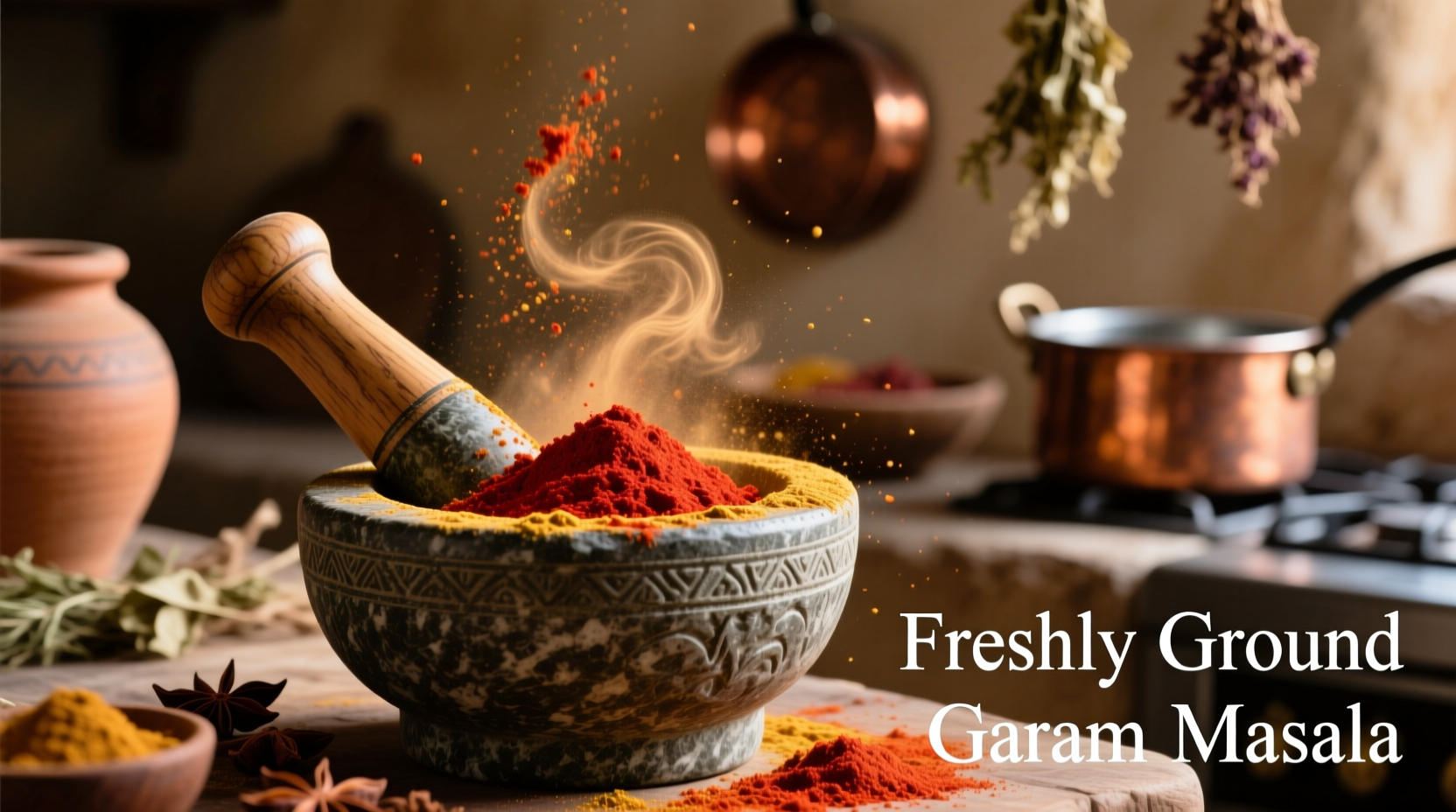Garam masala is a fragrant Indian spice blend typically containing 8-12 whole spices, with core ingredients including green cardamom, black cardamom, cinnamon, cloves, black pepper, cumin, and coriander. Regional variations exist between North Indian (warmer, sweeter profile) and South Indian (more complex, less sweet) versions.
Ever wonder what gives your favorite Indian dishes that distinctive warm, aromatic depth? The secret often lies in garam masala - a versatile spice blend that's the backbone of countless recipes across the Indian subcontinent. Unlike curry powder (a Western creation), garam masala is an authentic Indian spice mixture with roots tracing back centuries along ancient spice trade routes.
Why Garam Masala Composition Matters for Authentic Cooking
The term "garam masala" translates to "warm spice blend" in Hindi, referring to the heating properties these spices impart according to Ayurvedic principles, not their actual heat level. Understanding the precise composition helps home cooks achieve authentic flavors that store-bought versions often miss.
"Many commercial blends sacrifice complexity for consistency," explains Sarah Johnson, culinary historian specializing in spice traditions. "Traditional garam masala varies by region, household, and even season - that's where the magic happens."

Core Ingredients in Authentic Garam Masala
While recipes vary, these eight spices form the essential foundation of most traditional garam masala blends:
- Green Cardamom - Floral, citrusy notes (the "queen" of the blend)
- Black Cardamom - Smoky, camphorous depth (used more in North Indian versions)
- Cinnamon - Sweet warmth (Ceylon variety preferred)
- Cloves - Intense aromatic punch (use sparingly)
- Black Pepper - Sharp heat and complexity
- Cumin - Earthy, nutty foundation
- Coriander - Citrusy brightness that balances heavier spices
- Nutmeg - Warm sweetness (added toward the end of toasting)
Regional Variations: North vs South Indian Blends
One of the most fascinating aspects of garam masala is how it transforms across India's diverse culinary landscape. The following comparison reveals key differences:
| Characteristic | North Indian Garam Masala | South Indian Garam Masala |
|---|---|---|
| Primary spices | Cardamom, cloves, cinnamon, black pepper | Coriander, cumin, fenugreek, mustard seeds |
| Sweetness level | Higher (more cinnamon, cardamom) | Lower (more earthy spices) |
| Heat profile | Warmer ("heating" spices) | More complex, less focused on warmth |
| Typical use | Added at end of cooking | Used as tempering at beginning |
| Signature dishes | Butter chicken, biryani, korma | Sambar, rasam, vegetable curries |
Historical Evolution of Garam Masala
Understanding garam masala's development helps explain its regional diversity. This timeline reveals how trade and cultural exchange shaped the blend:
- 3000 BCE - Early spice trading documented in Indus Valley Civilization
- 500 BCE - Ayurvedic texts reference spice combinations for medicinal purposes
- 7th Century CE - Persian influences introduce new blending techniques through trade routes
- 16th Century - Mughal Empire refines North Indian versions with royal kitchen techniques
- 18th Century - European colonial powers document regional variations in trading records
- 20th Century - Commercial production standardizes blends, reducing regional diversity
When to Use Garam Masala: Practical Application Guide
Knowing how to use garam masala matters as much as knowing what's in it. Consider these context boundaries for optimal results:
- Best applications: Finish creamy curries, enhance rice dishes, boost lentil preparations, flavor meat marinades
- Avoid using: With delicate seafood, in tomato-heavy sauces (overpowers acidity), or in dishes already containing competing spice blends
- Timing matters: North Indian style adds at the end of cooking; South Indian versions often use as tempering at the beginning
- Quantity guide: Start with ¼ teaspoon per serving - you can always add more but can't remove excess
Creating Your Own Superior Garam Masala Blend
Store-bought versions often lack freshness and complexity. Making your own takes just 15 minutes and transforms your cooking:
- Toasting technique: Heat whole spices in a dry skillet over medium-low heat for 2-3 minutes until fragrant (don't burn!)
- Cooling period: Let toasted spices cool completely (10 minutes) before grinding
- Grinding method: Use a dedicated spice grinder or mortar and pestle for best results
- Proportion guide: Start with 2 tbsp coriander, 1 tbsp cumin, 1 tbsp cardamom, 1 tsp each cinnamon/cloves/pepper
- Storage tip: Keep in an airtight container away from light - use within 2 months for peak flavor
Common Substitutions When You're Missing Ingredients
Running low on a specific spice? These practical swaps maintain flavor integrity while using what you have:
- No cardamom? Use allspice (½ quantity) + touch of lemon zest
- No black pepper? Substitute with long pepper or pink peppercorns
- No cinnamon? Try cassia bark (use ⅓ less due to stronger flavor)
- Missing cloves? Replace with allspice (⅓ quantity) + drop of clove essential oil
Remember that substitutions alter the flavor profile - they're emergency solutions, not replacements for authentic ingredients. For best results, seek out Indian grocery stores or reputable online spice merchants for genuine components.
Preserving Flavor: Storage Techniques That Work
Garam masala's volatile oils begin degrading immediately after grinding. Maximize shelf life with these professional techniques:
- Store in dark glass or stainless steel containers (never plastic)
- Keep away from stove heat and direct sunlight
- Freeze whole spices before grinding for extended freshness
- Grind only what you'll use in 4-6 weeks
- Refresh stale blends by dry-toasting before use
"The moment you grind spices, the clock starts ticking on flavor," notes Johnson. "Whole spices maintain potency for 1-2 years, while ground versions lose 40% of volatile oils within a month."











 浙公网安备
33010002000092号
浙公网安备
33010002000092号 浙B2-20120091-4
浙B2-20120091-4